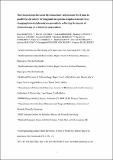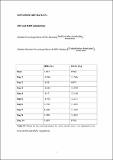Files in this item
The relationship between Mycobacterium tuberculosis MGIT time to positivity and cfu in sputum samples demonstrates changing bacterial phenotypes potentially reflecting the impact of chemotherapy on critical sub-populations
Item metadata
| dc.contributor.author | Bowness, Ruth | |
| dc.contributor.author | Boeree, Martin J | |
| dc.contributor.author | Aarnoutse, Rob | |
| dc.contributor.author | Dawson, Rodney | |
| dc.contributor.author | Diacon, Andreas | |
| dc.contributor.author | Mangu, Chacha | |
| dc.contributor.author | Heinrich, Norbert | |
| dc.contributor.author | Ntinginya, Nyanda E | |
| dc.contributor.author | Kohlenberg, Anke | |
| dc.contributor.author | Mtafya, Bariki | |
| dc.contributor.author | Phillips, Patrick P J | |
| dc.contributor.author | Rachow, Andrea | |
| dc.contributor.author | Plemper van Balen, Georgette | |
| dc.contributor.author | Gillespie, Stephen H | |
| dc.date.accessioned | 2015-10-24T23:11:09Z | |
| dc.date.available | 2015-10-24T23:11:09Z | |
| dc.date.issued | 2015-02 | |
| dc.identifier | 157165058 | |
| dc.identifier | 604a7382-f89c-43ab-8255-da83fa3fdf50 | |
| dc.identifier | 25344806 | |
| dc.identifier | 84922424155 | |
| dc.identifier | 000350211600013 | |
| dc.identifier.citation | Bowness , R , Boeree , M J , Aarnoutse , R , Dawson , R , Diacon , A , Mangu , C , Heinrich , N , Ntinginya , N E , Kohlenberg , A , Mtafya , B , Phillips , P P J , Rachow , A , Plemper van Balen , G & Gillespie , S H 2015 , ' The relationship between Mycobacterium tuberculosis MGIT time to positivity and cfu in sputum samples demonstrates changing bacterial phenotypes potentially reflecting the impact of chemotherapy on critical sub-populations ' , Journal of Antimicrobial Chemotherapy , vol. 70 , no. 2 , pp. 448-455 . https://doi.org/10.1093/jac/dku415 | en |
| dc.identifier.issn | 0305-7453 | |
| dc.identifier.other | ORCID: /0000-0001-6537-7712/work/39477821 | |
| dc.identifier.other | ORCID: /0000-0002-4090-5168/work/59698741 | |
| dc.identifier.uri | https://hdl.handle.net/10023/7686 | |
| dc.description | This work was supported by EDCTP who fund the PanACEA consortium (IP.2007.32011.011, IP.2007.32011.012, IP.2007.32011.013) and PreDiCT-TB consortium [IMI Joint undertaking grant agreement number 115337, resources of which are composed of financial contribution from the European Union’s Seventh Framework Programme (FP7/2007-2013) and EFPIA companies’ in kind contribution]. | en |
| dc.description.abstract | Objectives The relationship between cfu and Mycobacterial Growth Indicator Tube (MGIT) time to positivity (TTP) is uncertain. We attempted to understand this relationship and create a mathematical model to relate these two methods of determining mycobacterial load. Methods Sequential bacteriological load data from clinical trials determined by MGIT and cfu were collected and mathematical models derived. All model fittings were conducted in the R statistical software environment (version 3.0.2), using the lm and nls functions. Results TTP showed a negative correlation with log10 cfu on all 14 days of the study. There was an increasing gradient of the regression line and y-intercept as treatment progressed. There was also a trend towards an increasing gradient with higher doses of rifampicin. Conclusions These data suggest that there is a population of mycobacterial cells that are more numerous when detected in liquid than on solid medium. Increasing doses of rifampicin differentially kill this group of organisms. These findings support the idea that increased doses of rifampicin are more effective. | |
| dc.format.extent | 8 | |
| dc.format.extent | 822327 | |
| dc.format.extent | 492447 | |
| dc.language.iso | eng | |
| dc.relation.ispartof | Journal of Antimicrobial Chemotherapy | en |
| dc.subject | TTP | en |
| dc.subject | M. tuberculosis | en |
| dc.subject | TB | en |
| dc.subject | R Medicine (General) | en |
| dc.subject | NDAS | en |
| dc.subject | BDC | en |
| dc.subject | R2C | en |
| dc.subject | SDG 3 - Good Health and Well-being | en |
| dc.subject.lcc | R1 | en |
| dc.title | The relationship between Mycobacterium tuberculosis MGIT time to positivity and cfu in sputum samples demonstrates changing bacterial phenotypes potentially reflecting the impact of chemotherapy on critical sub-populations | en |
| dc.type | Journal article | en |
| dc.contributor.sponsor | European Commission | en |
| dc.contributor.institution | University of St Andrews. School of Medicine | en |
| dc.contributor.institution | University of St Andrews. Global Health Implementation Group | en |
| dc.contributor.institution | University of St Andrews. Gillespie Group | en |
| dc.contributor.institution | University of St Andrews. Biomedical Sciences Research Complex | en |
| dc.contributor.institution | University of St Andrews. Infection Group | en |
| dc.identifier.doi | 10.1093/jac/dku415 | |
| dc.description.status | Peer reviewed | en |
| dc.date.embargoedUntil | 2015-10-25 | |
| dc.identifier.grantnumber | en |
This item appears in the following Collection(s)
Items in the St Andrews Research Repository are protected by copyright, with all rights reserved, unless otherwise indicated.


